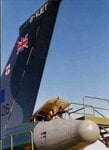Token
Senior Airman
As did the AAF with the B-29(B), not sure that was the official designation but that's how my uncle referred to them, they were the "strippers" used in the night attacks from Guam.
View attachment 603918
That is the AN/APG-15 radar. Several versions of this radar were used on different B-29 models and modifications, including an APG-15B in a twin .50 cal only rear gun position. In the Pacific these were a thing, but it never got to be a thing in Europe. A version of this was also done on the B-24, and while it reached the stage of ready for production it was not used in the field. It could have been, easily, if it became a requirement in Europe.
T!

